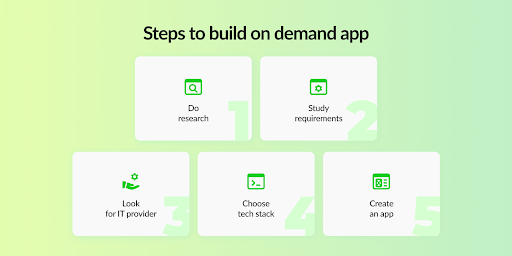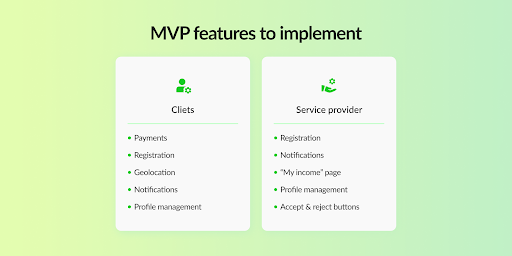The dramatic success of such mammoths as Uber, Airbnb, Flywheel, and Doordash has inspired entrepreneurs to open their “own”-like businesses and delve into this revenue model. That’s why startups start wondering how to create client-oriented on-demand applications and succeed.
If you’re one of those who want to make use of this trend, this post is for you. Look through it to learn how to start an on demand service app and how much money it requires.
Essence of On Demand Application
Before moving to the central (technical) part of our post, let’s outline what such a digital product stands for and what value it has for users.
In our fast-paced world, people don’t want to spend precious time looking for a nanny, doing laundry, or cooking at home (as an example). This is where on demand digital solutions come into play.
On demand service applications are designed to provide users with different types of services per request: from taxi services to flower/food delivery and online consultations with medical providers. They allow consumers to solve everyday problems (minor or major ones) in minutes by tapping a few buttons. In turn, business owners get a steady revenue flow proven by increased demand and market situations. For example, about 50% of American citizens prefer using on demand service apps due to their availability and convenience. Among other advantages are:
- Lower prices
- Minimum efforts
- A variety of solutions offered
- Adaptation to clients’ needs
How To Build On-Demand Delivery Service Apps: 5 Steps to Follow
Step 1. Research
Most business owners make a mistake focusing only on the technical part of the product. But coding only guarantees that the platform will perform fluently. It’s the client side that helps you define the target audience, its needs, and pains. Besides, in-depth analysis will help you provide a better user experience for customers. Finally, knowing who you design apps for will help you come up with the best possible digital solution.
Step 2. Requirements Analysis
Before looking for a reliable IT company, you need to strictly understand what your application should do. Simply put, this stage aims to create a product vision: functionality to add and custom design. Often, clients reach the tech partner with a request like: “I want an app like UberEats.” But it’s better not just to imitate the product but to consider unique functionality to stick out from rivals. This way, the app’s user flow is amended, but there’s no need to scrutinize the general requirements. You should also think over revenue models to transform your idea into a profitable asset.
Step 3. Hiring a Trustworthy IT Vendor
You can assemble an in-house team or cooperate with an outsourcing mobile app development company. The only argument in favor of in-house engineering is employees’ physical proximity, which implies smooth communication. However, the world is shifting towards remote work, so it’s not a compelling argument now. By outsourcing project development, the app development cost reduces while the speed to launch rises. That’s because such companies have already hired all the needed specialists, and their skills are appropriately tested. Moreover, you don’t need to worry about hidden costs or other unplanned expenses since the cost estimate is discussed beforehand.
Step 4. Selecting Tech Stack
The tech stack should adhere to project requirements and the specific platform(s) you want to cover. You can go native and roll out an app for both platforms or select cross-platform app development. For example, Swift’s official framework for building Apple-based solutions, while Android OS requires Java and Kotlin. Developing an on-demand platform with Flutter is an intelligent approach to accomplishing goals simultaneously. Cross-platform solutions have a single code base for both platforms, thus cutting the app’s architecting time.
Step 5 Development
When all the hassles are done, it’s time to kick off the product engineering under the approved requirements and technology list. Take it slowly; there is no sense in implementing all the features instantly. Instead, start with MVP building to ensure your project idea is viable and proof of demand. MVP version contains only the small set of components needed to ensure the performance of main options and meet basic user needs. After gathering early feedback, you can scale up your project by adding more complex functionality and smart technology, such as AI.
This isn’t a final blueprint for such a product deployment. The number of stages may differ from case to case basis as to the demands and commercial needs.
Technical Side of On Demand App Development: Features to Add
Before embarking on software creation, you should know its key elements. On demand apps’ logic implies two types of stakeholders: consumer and service supplier. It also requires an admin board to enable business owners to manage parties involved. Therefore, it’s needed to build two different solutions: user-facing and a provider solution.
MVP functionality for client app
Registration
This feature enables establishing personal touch with users, linking information to a particular client, and benefiting marketing and retargeting tools. Make the registration procedure fast and straightforward to cut the distance between the client and your app.
Profile administration
This functionality will allow users to set up and supervise their personal details: name, gender, age, address, preferred time of arrival, payments data, order history, etc.
Geolocation
This feature will allow receivers to track their deliveries or define the direction. Location-based options can be integrated using specialized 3rd party services, such as Google Maps.
Notifications
Flexible push notifications and alerts are an excellent means to earn more while improving “platform-customer” interaction. This way, users will be informed about order upgrades/reminders, expenditures, fulfilled queries, etc.
Payments
This will allow clients to pay for requested facilities featuring the platform. You can make custom payment services or integrate payment gateways, such as PayPal, Stripe, and Dwolla. In both cases, it’s critical to guarantee solid data security and fraud protection.
Features to insert into the provider’s app
Signing in and profile handling
Like consumers, facility providers should also be allowed to leave their credentials on the platform to avoid a tiring check-in process. For instance, you can add the “Login using” (e.g., Facebook) button to bridge the gap between user and new experience.
Push notifications
From the provider’s perspective, this option is necessary for sending alerts once the application for the service is submitted.
“My income” page
On-demand websites are a proven source of income. The more queries the company gets, the higher revenue is. Thus, service companies should be able to trace their earnings to ensure their proposals are proof of demand.
Accept & reject buttons
There are tons of requests service businesses should process. Therefore, companies should be capable of approving the appropriate queries or declining the improper ones within a predetermined time.
Remember: These are the indispensable group of features every on demand system MVP should include (despite the type). The core goals of creating an app MVP are to test waters, engage first movers, and compile first feedback. Thus, you can comprehend whether you need to develop your solution further or shift the focus. After you ensure mobile or web app resiliency, you can implement more complex functionality (e.g., AI chatbots, analytics, wishlists, recommendations) to enrich customer satisfaction and differentiate your product from contests.
What Does Affect On-Demand Service App Cost
How to calculate investment for such a digital startup? Unfortunately, no software development service provider can tell you the exact price until they are familiar with your requirements and what kind of app you want to deliver. The cost estimate ranges from $40,000 for simple solutions to $200,000+ for featured-rich ones. There are a variety of factors affecting the final price, such as the platform’s technical complexity, backend infrastructure, customization of visual elements, location of IT vendor, APIs integrations, etc.
I’ve decided to break down the on-demand app creation price based on feature complexity to provide insight into the average project cost.
Modest Solutions
Such systems imply the MVP version of the product. They aren’t packed with much functionality and have a plain user interface. Their core goal is to engage early consumers and gather user feedback (for further improvements). The price ranges from $40,000 to $130,000.
Average-complexity solutions
These types of software require more money, time, and constant enhancements. The developer’s approach individually to interface design and integrating more intricate functions. The project estimate begins from $130,000 and goes up to $250,000.
Complex solutions
Such solutions relate to enterprise-level ones (e.g., on-demand apps for logistics) and are made to digitize commercial operations and generate incomes. They’re custom-built and contain high-grade improved functions (e.g., real-time monitoring). The price starts from $250,000+.
Summing Up
Such a massive market as online on-demand services asks to be digitized and more accessible for everyone. And web/mobile platforms are time-tested tools to enhance customer experience yet get a steady income. On demand delivery service apps bring colossal value to users. They simplify the order monitoring process, save time, and streamline everything from leaving a request to receiving the desired service. Everything is just a click away, whether you need to arrive at a set destination or receive food delivery to the door. As for the business owners, they get an opportunity to make money successfully due to increased demand for such digital solutions.
Author’s bio
Yuliya Melnik is a technical writer at Cleveroad, a web and mobile app development company. She is passionate about innovative technologies that make the world a better place and loves creating content that evokes vivid emotions.



